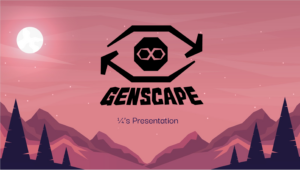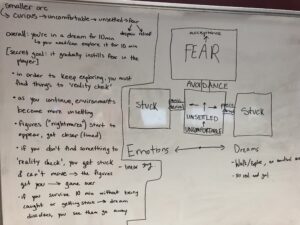
Week 3 was split into three neat sections for our team: final preparations for quarters, receiving feedback during quarters, and then using the end of the week to discuss and use that feedback as a team.
Leading up to quarters, our team revisited the three emotions we had initially proposed for our project: fear, sadness, and regret. We now knew that we wanted to focus specifically on evoking our central emotions directly in the player, rather than telling a story about a specific character experiencing that emotion. Narrowing down on this goal led to us removing “regret” from our list and replacing it with “loneliness.” Our reasoning was that regret relies on much more of a specific narrative than our other emotions. In order for the player to regret something, we would have to show them both the action they regret and the larger story context that would make them wish they hadn’t taken that action. Even then, the player might only feel “my character regrets doing this” rather than “I regret doing this,” which would be against our intention. We instead focused in on emotions that were more “primal” and able to be evoked quickly and personally.
During quarters, we received a good mix of interested questions and helpful criticisms. At the center of a lot of them was the fact that the exact purpose of our project was unclear to faculty. Was this project fundamentally about lucid dreaming, or about crafting an emotional journey? If this was a project about researching and replicating lucid dreams, why hadn’t we met with a subject matter expert yet? If this was a project about evoking emotion, where was a map or storyboard of our planned emotional arc? We could go in either direction, but we needed to communicate our choice clearly. Other faculty questioned our choice to begin with fear, which stood out to them as the most difficult emotion we had proposed. Finally, many faculty members encouraged us to toss out any aspects of our original pitch that no longer supported the experience we wanted to make, such as using procedural generation. Cutting down to just the essentials would hopefully lead to a much stronger and clearer project.
After quarters, our team sat down to review the feedback and decide on what to focus on moving forward. We all agreed that our main purpose was in crafting an emotional experience. The idea of lucid dreaming was secondary, and mostly provided an interesting setting in which to place our experience. Following that path, we began to map out exactly what emotional arc we wanted our experience to take players through. We eventually settled on an arc that took players from curious -> uncomfortable -> unsettled -> fearful -> relief/despair, with the final beat depending on if the player succeeds or fails at their overall objective. We recommitted to evoking this arc mostly through visual art, by placing the player in an environment that at first invites curiosity and exploration, but over time grows more and more foreboding.
As a discovery project, our main experiments will be about trying out different methods for taking players through these emotions, and then using playtests to see what emotions players actually report. In this way, our project is similar to the “naïve guest” assignment in Building Virtual Worlds. We are predicting the players emotions, and will be experimenting with various indirect control methods to evoke them. Moving into next week, we plan to develop a test scene focused on one section of our emotional arc (for example, curiosity to discomfort), and use it to run a playtest by the end of the week.

